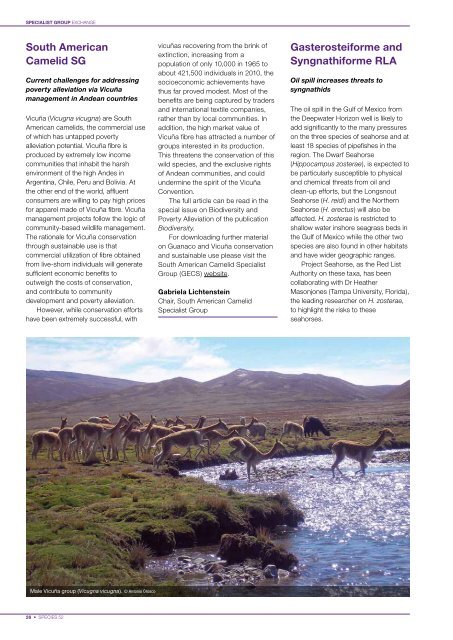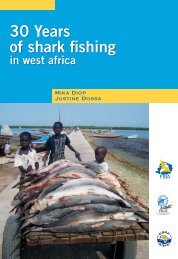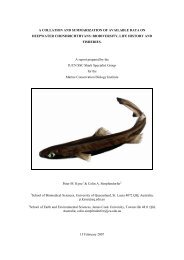Magazine of the species survival Commission specialist Group - IUCN
Magazine of the species survival Commission specialist Group - IUCN
Magazine of the species survival Commission specialist Group - IUCN
Create successful ePaper yourself
Turn your PDF publications into a flip-book with our unique Google optimized e-Paper software.
<strong>specialist</strong> group exchange<br />
South American<br />
Camelid SG<br />
Current challenges for addressing<br />
poverty alleviation via Vicuña<br />
management in Andean countries<br />
Vicuña (Vicugna vicugna) are South<br />
American camelids, <strong>the</strong> commercial use<br />
<strong>of</strong> which has untapped poverty<br />
alleviation potential. Vicuña fibre is<br />
produced by extremely low income<br />
communities that inhabit <strong>the</strong> harsh<br />
environment <strong>of</strong> <strong>the</strong> high Andes in<br />
Argentina, Chile, Peru and Bolivia. At<br />
<strong>the</strong> o<strong>the</strong>r end <strong>of</strong> <strong>the</strong> world, affluent<br />
consumers are willing to pay high prices<br />
for apparel made <strong>of</strong> Vicuña fibre. Vicuña<br />
management projects follow <strong>the</strong> logic <strong>of</strong><br />
community-based wildlife management.<br />
The rationale for vicuña conservation<br />
through sustainable use is that<br />
commercial utilization <strong>of</strong> fibre obtained<br />
from live-shorn individuals will generate<br />
sufficient economic benefits to<br />
outweigh <strong>the</strong> costs <strong>of</strong> conservation,<br />
and contribute to community<br />
development and poverty alleviation.<br />
However, while conservation efforts<br />
have been extremely successful, with<br />
vicuñas recovering from <strong>the</strong> brink <strong>of</strong><br />
extinction, increasing from a<br />
population <strong>of</strong> only 10,000 in 1965 to<br />
about 421,500 individuals in 2010, <strong>the</strong><br />
socioeconomic achievements have<br />
thus far proved modest. Most <strong>of</strong> <strong>the</strong><br />
benefits are being captured by traders<br />
and international textile companies,<br />
ra<strong>the</strong>r than by local communities. In<br />
addition, <strong>the</strong> high market value <strong>of</strong><br />
vicuña fibre has attracted a number <strong>of</strong><br />
groups interested in its production.<br />
This threatens <strong>the</strong> conservation <strong>of</strong> this<br />
wild <strong>species</strong>, and <strong>the</strong> exclusive rights<br />
<strong>of</strong> Andean communities, and could<br />
undermine <strong>the</strong> spirit <strong>of</strong> <strong>the</strong> Vicuña<br />
Convention.<br />
The full article can be read in <strong>the</strong><br />
special issue on Biodiversity and<br />
Poverty Alleviation <strong>of</strong> <strong>the</strong> publication<br />
Biodiversity.<br />
For downloading fur<strong>the</strong>r material<br />
on guanaco and vicuña conservation<br />
and sustainable use please visit <strong>the</strong><br />
South American Camelid Specialist<br />
<strong>Group</strong> (GECS) website.<br />
Gabriela Lichtenstein<br />
Chair, South American Camelid<br />
Specialist <strong>Group</strong><br />
Gasterosteiforme and<br />
Syngnathiforme RLA<br />
Oil spill increases threats to<br />
syngnathids<br />
The oil spill in <strong>the</strong> Gulf <strong>of</strong> Mexico from<br />
<strong>the</strong> Deepwater Horizon well is likely to<br />
add significantly to <strong>the</strong> many pressures<br />
on <strong>the</strong> three <strong>species</strong> <strong>of</strong> seahorse and at<br />
least 18 <strong>species</strong> <strong>of</strong> pipefishes in <strong>the</strong><br />
region. The Dwarf Seahorse<br />
(Hippocampus zosterae), is expected to<br />
be particularly susceptible to physical<br />
and chemical threats from oil and<br />
clean-up efforts, but <strong>the</strong> Longsnout<br />
Seahorse (H. reidi) and <strong>the</strong> Nor<strong>the</strong>rn<br />
Seahorse (H. erectus) will also be<br />
affected. H. zosterae is restricted to<br />
shallow water inshore seagrass beds in<br />
<strong>the</strong> Gulf <strong>of</strong> Mexico while <strong>the</strong> o<strong>the</strong>r two<br />
<strong>species</strong> are also found in o<strong>the</strong>r habitats<br />
and have wider geographic ranges.<br />
Project Seahorse, as <strong>the</strong> Red List<br />
Authority on <strong>the</strong>se taxa, has been<br />
collaborating with Dr Hea<strong>the</strong>r<br />
Masonjones (Tampa University, Florida),<br />
<strong>the</strong> leading researcher on H. zosterae,<br />
to highlight <strong>the</strong> risks to <strong>the</strong>se<br />
seahorses.<br />
Male Vicuña group (Vicugna vicugna). © Antonio Orosco<br />
26 • <strong>species</strong> 52
















